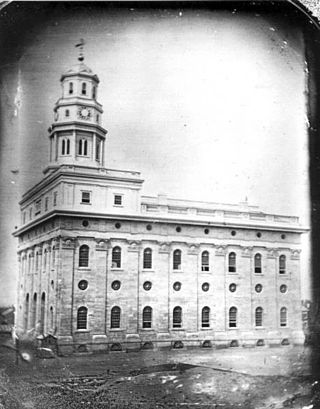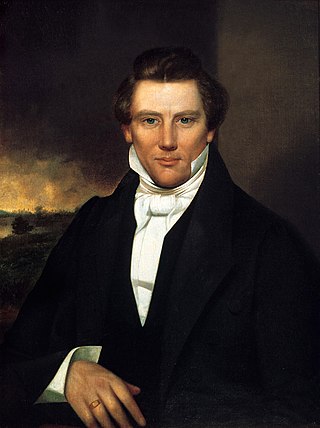
The Red Brick Store in Nauvoo, Illinois, was a building constructed and owned by Joseph Smith, founder of the Latter Day Saint movement.

The Red Brick Store in Nauvoo, Illinois, was a building constructed and owned by Joseph Smith, founder of the Latter Day Saint movement.

Smith constructed the Red Brick Store in 1841. The building became a center of economic, political, religious, and social activity among the Latter Day Saints. In addition to being a mercantile store, the second floor of the building was also for a period of time the headquarters of the Church of Jesus Christ of Latter Day Saints. Members would visit the store to pay their tithing and other offerings to the church.
A number of important events in Latter Day Saint history occurred in the Red Brick Store, including:

After Joseph Smith was killed and the majority of Latter Day Saints left Nauvoo, the Red Brick Store fell into disrepair. Eventually, it was torn down and the bricks were used to construct new buildings in Nauvoo.
In 1980, the Reorganized Church of Jesus Christ of Latter Day Saints (now known as Community of Christ) rebuilt the Red Brick Store on the original foundation as part of its 1980 sesquicentennial celebrations. The reconstructed Red Brick Store is now owned and operated by the Church of Jesus Christ of Latter-day Saints, which purchased the structure on March 5, 2024, as part of a larger sale of historically significant artifacts and properties by the Community of Christ. [4]
In Manti, Utah, the headquarters of the True and Living Church of Jesus Christ of Saints of the Last Days is located in a building named the Red Brick Store in honor of Smith's original structure in Nauvoo.

Sidney Rigdon was a leader during the early history of the Latter Day Saint movement.

Elizabeth Ann Smith Whitney was an early Latter Day Saint leader, and wife to Newel K. Whitney, another early Latter Day Saint leader. She went by her middle name, Ann.

The Latter Day Saint movement is a religious movement within Christianity that arose during the Second Great Awakening in the early 19th century and that led to the set of doctrines, practices, and cultures called Mormonism, and to the existence of numerous Latter Day Saint churches. Its history is characterized by intense controversy and persecution in reaction to some of the movement's doctrines and practices and their relationship to mainstream Christianity. The purpose of this article is to give an overview of the different groups, beliefs, and denominations that began with the influence of Joseph Smith.

Washing and anointing is a Latter-day Saint practice of ritual purification. It is a key part of the temple endowment ceremony as well as the controversial Second Anointing ceremony practiced by the Church of Jesus Christ of Latter-day Saints and Mormon fundamentalists. It was also part of the female-only healing rituals among Latter-day Saints until at least the 1940's.

William Marks was an early leader in the Latter Day Saint movement and was a member of the First Presidency in the Reorganized Church of Jesus Christ of Latter Day Saints. Marks is mentioned in the Doctrine and Covenants in sections 117 and 124 of the Church of Jesus Christ of Latter-day Saints edition and in section 115 of the Community of Christ edition.

The Nauvoo Temple was the second temple constructed by the Church of Jesus Christ of Latter Day Saints. The church's first temple was completed in Kirtland, Ohio, United States, in 1836. In the winter of 1846, when the main body of the church was forced out of Nauvoo, the church attempted to sell the building, finally succeeding in 1848. The building was damaged by arson and a tornado before being demolished.

The Kirtland Temple is the first temple built by adherents of the Latter Day Saint movement, located in Kirtland, Ohio, and dedicated in March 1836. Joseph Smith, the movement's founder, directed the construction following a series of reported revelations, and the temple showcases a blend of Federal, Greek Revival, and Gothic Revival architectural styles. It was added to the National Register of Historic Places in 1969 and named a National Historic Landmark in 1977. Prior to March 5, 2024, the temple was owned and operated by Community of Christ for over a century before ownership transferred to the Church of Jesus Christ of Latter-day Saints.

John Alpheus Cutler was an early leader in the Latter Day Saint movement who founded the Church of Jesus Christ (Cutlerite) in 1853. He had previously served in several church positions under Joseph Smith, founder of the Latter Day Saint movement, as well as captain of Smith's personal bodyguard and "Master Builder and Workman on all God's Holy Houses." Following the death of Joseph Smith in June 1844, Cutler at first followed the Twelve Apostles under Brigham Young, but later left Young's church to reorganize the Church of Jesus Christ, with himself serving as its first president. Cutler claimed that this was the sole legitimate continuation of Smith's organization, and he served as its leader until his death.
The succession crisis in the Latter Day Saint movement occurred after the killing of the movement's founder, Joseph Smith, on June 27, 1844.

Newel Kimball Whitney was a prominent member and leader in the Latter Day Saint movement and an American businessman. Whitney married Elizabeth Ann Smith in 1822. He owned a store and an ashery in Kirtland, and acquired more property as his business grew. Initially he was part of the Disciples of Christ or Campbellite movement. He joined the early Latter Day Saint church, called the Church of Christ, in 1830 after his Campbellite bishop, Sidney Rigdon also joined the church. Whitney greatly contributed financially to the growing church, paying taxes on its property and paying off the debts incurred by the United Firm. He traveled to other states for business and as part of his duties as a Bishop. In Nauvoo, he was part of the Quorum of the Anointed, consented for his daughter to become a plural wife of Joseph Smith, and participated in plural marriage. He served as the second Presiding Bishop of the Church of Jesus Christ of Latter-day Saints from 1847 until his death. He died in 1850 of pleurisy.
Granville Hedrick was a leader in the Latter Day Saint movement after the 1844 succession crisis. In 1863, Hedrick became the founding leader of the Church of Christ, which is one of many churches that claim to be a continuation of the Church of Christ founded by Joseph Smith in 1830.
George Washington Robinson was a leader during the early history of the Latter Day Saint movement being the first secretary to the First Presidency of the Church of Jesus Christ of Latter Day Saints. He was also a Danite leader and an official church recorder in the 1830s and was a member of the Quorum of the Twelve Apostles in the Rigdonite church established in 1845.
George Miller was a prominent convert in the Latter Day Saint movement and was the third ordained bishop in the Latter Day Saint church.

Nauvoo Historic District is a National Historic Landmark District containing the city of Nauvoo, Illinois. The historic district is nearly coterminous with the City of Nauvoo as it was incorporated in 1840, but it also includes the Pioneer Saints Cemetery, the oldest Mormon cemetery in the area, which is outside the town boundary.
Nancy Rigdon was the daughter of Sidney Rigdon, an early leader in the Latter-day Saint Movement. In 1842, she was the recipient of a controversial letter written by Joseph Smith, after she refused his offer of polygamous marriage.

In the Church of Jesus Christ of Latter-day Saints, a temple is a building dedicated to be a House of the Lord. Temples are considered by church members to be the most sacred structures on earth.

The Joseph Smith Mansion House in Nauvoo, Illinois is a large residence first occupied by Joseph Smith, the founder of the Latter Day Saint movement. Smith used the house as a personal home, a public boarding house, a hotel, and as a site for the performance of temple ordinances.
The University of Nauvoo was a short-lived university in Nauvoo, Illinois.
In the theology of the Latter Day Saint movement, an endowment refers to a gift of "power from on high", typically associated with the ordinances performed in Latter Day Saint temples. The purpose and meaning of the endowment varied during the life of movement founder Joseph Smith. The term has referred to many such gifts of heavenly power, including the confirmation ritual, the institution of the High Priesthood in 1831, events and rituals occurring in the Kirtland Temple in the mid-1830s, and an elaborate ritual performed in the Nauvoo Temple in the 1840s.

The following outline is provided as an overview of and topical guide to the life and influence of Joseph Smith: